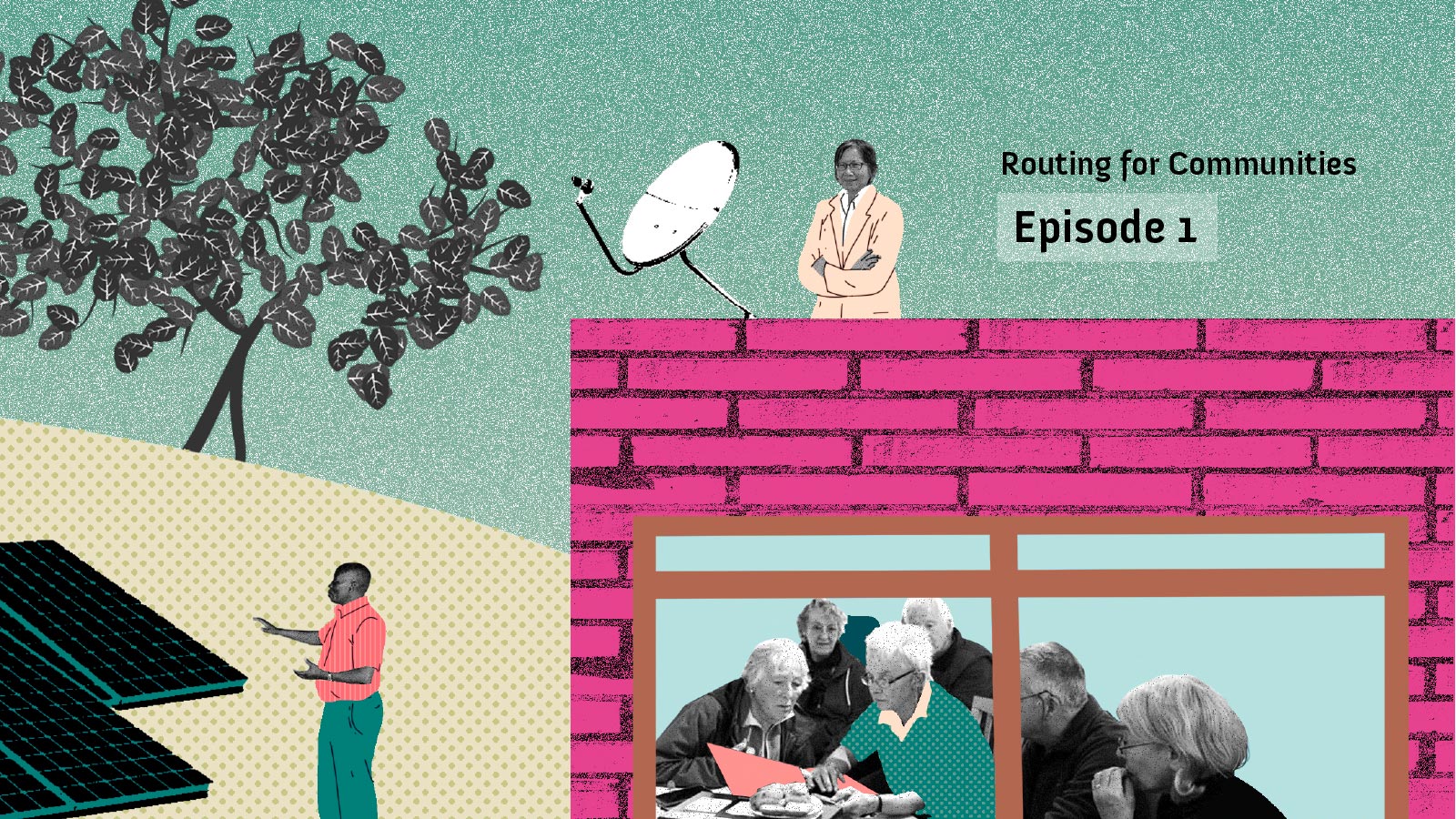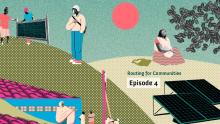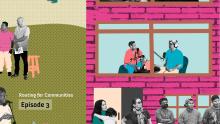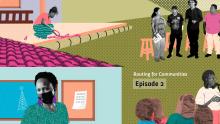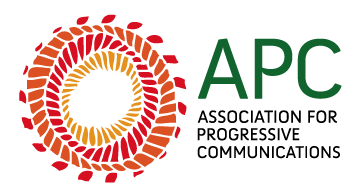#1 What changes when the internet connection is centred in communities?
We’re back! The premiere of the second season of the Routing for Communities podcast is on the air. In our first season, you listened to life stories of those who create innovative, community-led projects that connect the one-third of humankind that is still living offline. Throughout the 12 episodes, we talked to more than 20 people from 15 countries. The topic provided us with a lot of content, so we decided to extend the conversation into one more season for you.
Now, we continue addressing community networks. In this first episode, the topic is community-centred connectivity as a strategy that communities have developed for bridging the digital divide. Do you know what kind of digital gaps persist in different regions around the world? How do they impact people’s lives? How does this lack of connectivity deepen local inequalities?
Join us on this audio journey and find out more.
All the interviews in this episode were recorded in 2023 for the first season of our podcast. The information and perspectives shared reflect the context of that time.
Hello! We're back! Welcome to season two of the “Routing for Communities" podcast. Stories and voices that are intertwined, connected by one thread: building internet and communication community networks.
Hi! My name is Thiago Moyano, from Brazil, and I'm the host of this four-episode season.
In our first season, you listened to life stories of those who create innovative, community-led projects that connect the one-third of humankind that is still living offline. Do you remember some of the initiatives we brought to you in season one? Here is just a small taste of some of the community network builders and supporters we have interviewed.
Throughout the 12 episodes, we talked to more than 20 people from 15 countries to tell you about innovative, diverse connectivity experiences built by the communities themselves. In this second season, we continue addressing community networks. But this time, the episodes are based on four central themes.
In this premiere, the topic is “community-centred connectivity as a strategy that communities developed for bridging the digital divide”. Do you know what kind of digital gaps persist in different parts around the world? How do they impact people’s lives? How does this lack of connectivity deepen local inequalities? What kind of technologies make sense in territories and communities to support people’s well-being?
Join us! In this podcast we will help you think about possible answers to these questions, based on what the interviewees from the first season told us. The topic provided us with a lot of content. So, we decided to extend the conversation into more episodes for you.
This is Routing for Communities, an audio journey tracing community connectivity around the world, season two, first episode.
According to the publication “Measuring digital development: Facts and figures 2021”, around 37% of the world's population has never used the internet. That's almost three billion people. In fact, according to the United Nations, there are also some three billion people who do not have access to clean water and soap. These three billion are people who suffer from multiple social, economic, cultural and… technological inequalities.
The digital divide can be worse, depending on the country, and also if we look at differences regarding gender, age, income, or between urban and rural areas, for example. And community networks are a viable alternative to bridge such a digital gap. But tell me: do you know what a community network is?
(voices from around the world)
Well, community networks are community-centred connectivity initiatives that can provide an internet and other access-enabled infrastructure set up by, owned and/or run by a local community for its benefit, according to their own visions and rules. They are so named because local communities are involved in them in one way or another. It could be, for example, in deploying, owning and/or operating the physical infrastructure that supports voice or internet connectivity, in addition to other local digital services.
They can cultivate bottom-up, sustainable approaches to communication technology and connectivity that strengthen autonomy and self-determination, because it is the community that knows what it needs the access for, and on what terms.
But to make this concept more concrete for you, I will return here to some community-centred connectivity experiences around the world that we recorded in the first season of the podcast. And if you want to know more about them, just search for the episodes in your player. Each one of the 12 episodes tells a story from one country. To make it easier for you, we have a brief description of each episode in the links to the experiences that I will bring to you now.
So, let's start this journey by travelling to South Africa!
“Hello. My name is Lungelo Mtwa. I am from Pondoland. I am 27 years old this year and I am part of Amadiba Community Network. My village, Amadiba, is like the whole of Pondoland. We are a rural village, some people from outside regard us as primitive people. They say we are living in the past because our village is still very natural, very raw. And our houses are actually scattered, maybe 500 metres in between, from one house to the other. And that space between the houses, we use it for farming, also for grazing. So we are in a rural area which is close to the ocean, a very unspoiled wild ocean.
The reason why we started a community network is because we have a problem with the signal in our area, so we saw that having Wi-Fi in the community will be very helpful. We have many stories to share with the world. We have struggles and victories. We need to share these with the people who are also threatened with similar stuff that we are also being threatened with. We are always saying we want to bridge the digital divide, so having the network will mean that. Our people will have access and will be connected to the world.
Our reasons why we are fighting against this mining and stuff is because we know that we are Indigenous people of this land, and we belong to the land; we are dependent on the land. We know that we are going to be moved once the mining comes in, we are going to be relocated.”
This mining that Lungelo mentions is a titanium mining project that has threatened the community for years. People of the region need to use all available tools in this resistance against depredations by international corporations. This is why creating the community network was even more necessary and had an important political impact in this struggle.
The Amadiba Community Network is exemplary when we talk about digital gaps and defending the territories of the most marginalised populations. But community networks contribute in many ways to also preserve the cultures of these places.
This is, for example, the case in Colombia, in an Indigenous community where the Jxa'h Wejxia Casil community network is operating. Listen now to a member of the Nasa Indigenous nation speaking in the language Nasa Yuwe.
“Please receive salutations from Edinson Camayo Guetio. I am a zone councilman. In order to become one there is an autonomous governmental structure. I’m from the municipality of Caldono, from the state of Cauca, Colombia. In the Caldono township there are approximately six Indigenous reservations and each one has its own autonomous governance. Pueblo Nuevo, which is Khwe'nxa Cxhah, is my reservation and I am their representative at the cabildos [local government bodies] association.
At first, since our parents grew up in the fields in a communal dynamic, we started out in community work, community groups, and the strengthening of our own cultural identities. And that’s when we realised that we have to have technological autonomy and relevant communication. And then, we said, ‘Well, we’re offline here.’
So, we started to work on it. We got a group of young people from the community and began to train them on the importance of communication.
We looked at it from two perspectives: what is communication within the framework of our worldview, and also what Western communication is. Then, we started the discussion about different kinds of technologies, those that the community already had access to and those that were still coming.
We have already entered not only the internet, but we have also begun to strengthen the 2G mobile community right now. This is used for security only, exclusively by the Indigenous guard. But we also said among our people, ‘We are going to buy a transmitter, a transistor, for a television.’ And we also have a community television right now. But our dream is to reach almost a regional level, and we are projecting that.”
Preserving and disseminating culture is also the focus of another community-centred initiative that supports and creates community networks in another country: Indonesia. I’m talking about the Common Room Networks Foundation. Its co-founder talked to us about their project that works with art, culture, communication and new technologies in a territory very much attached to ancestral traditions, in the middle of mountains and a dense forest.
“Good morning. My name is Gustaff, my second name is Harriman Iskandar. I work with Common Room. It's a non-profit organisation working in developing an open platform for art, culture and ICT media in Bandung.
Our initiative on community networks started to develop, especially, when we started to do projects with Ciptagelar Indigenous community in West Java, while trying to set up the local internet infrastructure in the region.
The people in that region have a very interesting and unique tradition, a traditional farming culture. The location is in the deep forest of Halimun Salak National Park. I think the forest itself is a very important tropical forest reserve in West Java. Because, as you probably noticed, West Java is one of the fastest growing regions in Indonesia.
The digital divide challenge in Indonesia is quite complex, not only because of its geographical context. As you probably know, in Indonesia we have maybe around 17,000 different islands, with different conditions and challenges. There are highlands, coastal regions, forest areas, remote islands, and so on. So this kind of geographical settings is quite unique, and we have to find specific ways to develop the internet infrastructure in order to provide connectivity for people in many different islands.
We have been learning a lot, that the community network is not merely about the physical internet infrastructure per se. In order to have an appropriate approach on internet developments among rural communities, we also need to conduct a cultural approach and recognise local culture and traditions, because the internet is not only a new platform that can be utilised by the local communities to communicate and to access information, but also it can be very useful to enhance the artistic and cultural expressions.”
These regions where community networks are built have many differences between them, but there is one commonality: lack of interest from large telecommunications companies in providing affordable connectivity, or any connectivity at all, to areas they deem unfeasible, profit-wise.
Thus, populations that are often already marginalised suffer even more from such technological exclusion. In Mexico, for example, the major cell phone companies in the country control about 97% of the sector, with their profit-driven agenda. These companies do not offer services for many rural or impoverished areas.
So, the solution to this scenario is arising from these excluded communities themselves. That was the case of Wiki Katat, the first Indigenous virtual operator providing internet and mobile phone services in Mexico. Wiki Katat offers cell phone and mobile internet services under many different plans at a low cost, and it is possible to access services through their own operator and buy mobile chips.
“Well, hello, my name is Floriberta Lino de Jesús. I am from a community called Tepoztlán, in the state of Puebla, Mexico. I am a proudly Indigenous woman.
Well, Cuetzalan is a magical town. They say it's magical because it has many waterfalls, hills and Cuetzalan is green. There's a lot of vegetation. It has a wealth of flora and fauna. Normally, whenever someone comes to visit Cuetzalan, I always tell them, ‘Don't stay in Central Cuetzalan, go to the communities.’ Because that's where the good stuff really is. I'm talking about communities because it's a rural area. There are paths, there are cornfields, there is coffee, creeks and waterfalls.
The pandemic arrived and we were worried because there was something that began to happen a lot, which is that the children were not studying. And education was no longer free because now, to have access to classes, you had to recharge for 50 pesos or 100 pesos, and those 100 pesos were meant for a kilo of sugar, they were for a kilo of beans. We had to start creating a social enterprise that would make us sustainable, thought up in our territory and strengthening the social and solidarity economy of the communities. That was when our dream of having a community mobile operator was born, which is Wiki Kakat.”
As in Mexico, community networks have consolidated themselves as an economically viable alternative in several other places. That's the case of B4RN (Broadband for the Rural North). This is a community benefit society in England, which means that the organisation must serve the broader interests of the community and that any surplus has to go right back into the community.
The members of the community themselves own the initiative that takes internet connection to the residents of many villages in the region. B4RN’s official price to users is closer to GBP 0.03 per megabit per month when the average cost for broadband in the United Kingdom is around GBP 0.86 per megabit (almost USD 1).
Let's listen to one of B4RN’s founders.
“Hi, my name's Chris Conder. I'm 69 years old at the moment. I've been involved with trying to get internet connectivity to my communities since I was 40, so I've been doing this for 29 years.
And we went to the city council, who were going to be our sponsors, because we weren't anybody, we were just a management team of community nutcases. So the project would be fronted by the city council, who were fully supportive of getting the internet to eight of their parishes at no cost to themselves, because this was a grant. And so, three quarters of a million pounds according to our plans would have built a backbone. So, from a breakout point of dark fibre, we could then feed our own fibre to our eight communities.
And the village postman was having his hair cut, with the village hairdresser, and the village hairdresser was droning on like she did, instead of about holidays, which most hairdressers drone on about, she was droning on about broadband. And how the original plan was to go through the roads and pavements. And this postman, who drove all over those eight parishes, just like the hairdresser, said, ‘Instead of using all the roads which will take forever, why don't you just go over the farms and you just skip over the fells through the easy peat, dig through that and you're there in a jiffy and it's not going to cost you very much, because the farmers will dig it for you, because the farmers on the fells are desperate for a good connection. And do it that way.’ So that was the actual seed that started the theory that yes, we can do it ourselves.
We've done it and we've done it really, really well, and it works and it's viable and it's economical and it's owned by the people; it's looked after by the people. It's built so much community cohesion. It is unbelievable how everybody in the community has got to know everybody else and gone on to help the next community and the next parish and got to know them. And they’re still supportive now.”
Have you noticed that in all these experiences that I am sharing here, and which are from countries so different from each other, what they have in common is that they emerge from the initiatives of the communities, addressing their needs and desires?
They are community-centred connectivity initiatives. In other words, connectivity that is shaped by the community itself in a way that reflects the different interests and relationships within the community, even if the community itself does not directly provide the infrastructure and services.
This community-centred connectivity is what moves the passion of Professor Kanchana Kanchanasut’s pioneering venture, which took the internet to Thailand. Nowadays, she is in charge of Taknet, Thailand's first community network. She was also the first person to create an email account in her country, besides having been the one who registered, in 1988, the internet domain “.th”, which is still the official domain in Thailand.
In her country, the need for a community network also became even more urgent with the COVID-19 pandemic, especially due to the educational demand.
“Hello. My name is Kanchana Kanchanasut. I am from Thailand and I work at the Asian Institute of Technology. I used to be a professor in computer science until my retirement.
I found that the connectivity in the rural areas in Thailand was still very poor. So I was working on a mobile ad hoc network. I was aiming at a post-disaster environment scenario. It happened that there was a big flood in Thailand in 2011.
So, I decided that we should try to introduce this technology to people, try to do one village, and we tried to introduce the idea to get the people to get to know what the internet is and not to be afraid of technology. It was in 2013. And since then, once you get start to get involved, you cannot leave!
The idea of introducing community network to the village was, to me, like when I started to introduce the internet to Thailand, it was very similar in many aspects.
The disparity between the rich and the poor in Thailand is quite wide. In the big city people are used to the internet, they have very good facilities. And the government introduced the use of the internet in so many curricula for schools nationwide. The children in the villages were asked to do their homework using the internet, and their parents and their family had to allow the kids to go to town, to an internet cafe. And the parents were not happy about it. That was the situation before we went into the village.
So, once we started to introduce the network to them, and then the children could stay home, that was the start of the real deployment of our community network, because the parents started to appreciate what we were doing.
I believe that the concept of having the local community to build their own network, particularly for those remote villages, they should be able to decide what they want to do with their own community. They should not sit and wait for the provider to come and decide things. So, we are trying to convince people to go in this direction.”
But we know very well that technologies and connectivity are not always positive themselves. The internet can also cause problems, right? There is no shortage of examples in the world, such as the dissemination of fake news, prejudice, extremism, cybercrimes and so on.
That's why the local experiences we are sharing in this podcast show that community leadership is central to having these positive outcomes. Not only do community networks help address digital divides, but they also help us rethink connectivity and digital inclusion strategies in a way that enhances positive impacts and reduces risks.
“Hi, my name is Carlos Rey-Moreno. I am originally from Spain, although I've been a bit all over. Currently I'm in Australia and I work for the Association for Progressive Communications, co-managing the programme on local access networks and leading the LocNet initiative.
Telecommunications is a highly regulated space where, in order to provide services, you need to pay rather hefty fees.
I think it's in the interest of everyone, if we want to close the digital divide, to understand that there is the need to create a more enabling environment for the small operators that don't want to provide services outside their villages, that don't want to become a multinational company, and that the same rules do not apply and cannot apply in terms of fees, in terms of bureaucracy, in terms of taxes. If you want to incentivise [to ensure] that those communities are the ones solving their own problems, problems that in many cases the market cannot solve for them… so, thinking that other types of regulations, other types of incentives are required to make sure that everyone is connected, it is necessary and it's possible. There are many examples of countries where regulators and policy makers are understanding this need and are really transforming the regulatory framework to make a space for these other complementary types of operators, which are very much needed.”
More than defending community networks as a perfect model, the programme on local access networks, the LocNet initiative, is proposing a set of principles and values that focus on the community as a key stakeholder for digital inclusion, and also defining “meaningful community-centred connectivity”. Have you ever heard this expression? It is connectivity that operates in a local context where it is affordable and accessible in terms of the local language, location and devices, with the connectivity meeting the expressed needs of the community and adding value to its people’s personal, social and/or economic lives.
We believe that people must have opportunities, abilities and resources to achieve that, in order to strengthen local well-being, economies and cultures. And we hope these stories we shared with you in this episode inspire you to act and help to build solutions to digital gaps in communities around the world.
If you liked this podcast, please recommend it to those you know will appreciate it as well.
If you want to know more about the projects we talked about here, check out the links we have provided in this episode’s description.
You can follow the season on the main podcast platforms or on APC’s website: routingforcommunities.apc.org.
We'll meet again soon, with our second episode, when we will talk about women in community networks.
You just listened to the first episode of season two of “Routing for Communities: An audio journey tracing community connectivity around the world”. This is the podcast of the Local Networks (LocNet) initiative, a collective effort led by APC and Rhizomatica. Production: Rádio Tertúlia.
Thanks, and see you next time! Bye!
This podcast is an initiative from the Association for Progressive Communications (APC) and Rhizomatica, produced by Rádio Tertúlia.
Presentation: Thiago Moyano.
Script, editing and sound: Beatriz Pasqualino.
Interviews: Vivian Fernandes.
Coordination: Beatriz Pasqualino and Débora Prado.
Consulting board: Flavia Fascendini, Florencia Roveri and Kathleen Diga.
Illustrations: Gustavo Nascimento.
Web design: Avi Nash and Cathy Chen.
This production is part of the “Meaningful community-centred connectivity” project being implemented by the Local Networks (LocNet) initiative (http://apc.org/locnet) , with financial support from the Swedish International Development Cooperation Agency (Sida) and UK International Development from the UK Government through its Digital Access Programme. The views expressed here do not necessarily reflect the supporters’ views.
